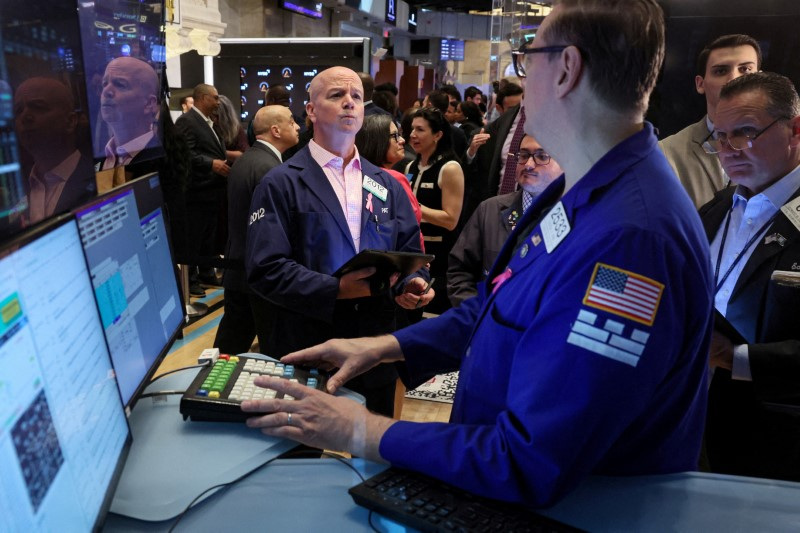Yields fall after benign producer inflation data tees up CPI
By Alden Bentley
NEW YORK (Reuters) -U.S. Treasury yields declined on Tuesday after the release of a tame producer prices report that looked unlikely to divert the Federal Reserve from an easing path, with Wednesday's consumer prices data set to fill out the inflation picture.
The July Producer Price Index increased a less-than-expected 0.1%, after rising 0.2% in June, the Labor Department said, as a rise in the cost of goods was tempered by cheaper services. In the 12 months through July, the PPI increased 2.2%, backing down from a 2.7% rise in June.
Vail Hartman, U.S. rates strategist at BMO Capital Markets in New York, said CPI and PPI are not highly correlated and the market took the data in stride. PPI should not throw the Fed off course because parts of it contribute to the Personal Consumption Expenditures price index, which the Fed relies on most to guide policy, he said.
"Just looking at the PPI data, and specifically the elements that feed into core PCE, I don't think there was anything truly alarming and, from a broader perspective, I think the data
conforms with the disinflation narrative."
The report also sent stocks soaring and the dollar lower.
Slowing inflation and a cooling labor market have led financial markets to anticipate that the Federal Reserve will start its easing cycle in September. With inflation behaving and the unemployment rate surging to near a three-year high of 4.3% in July, an interest rate cut of 50 basis points from its current 5.25% to 5.50% range cannot be ruled out.
The July Consumer Price Index is due at 0830 EDT/1230 GMT on Wednesday. Thursday also brings indicators such as retail sales and weekly jobless claims. Claims have taken on more importance recently because of the Fed's scrutiny of labor market conditions.
"The market is hoping they confirm slowing in the economy that will also give the Fed more excuse to cut rates," said Kim Rupert, managing director, fixed income at Action Economics in San Francisco.
Futures markets reflect odds of about 54% that the Fed will cut 50 bps against 46% for a 25 bps cut, a flip around from late Monday. Traders are pricing in a full percentage point of easing by year-end.
Atlanta Fed President Raphael Bostic on Tuesday said unemployment is still historically low and the labor market was strong, predicting a rate cut by year end.
Speaking at an event in Atlanta, Bostic noted that the balance of risks between inflation and the job market are closer to level, but he wants to be sure the Fed avoids cutting rates too soon.
Bond yields fell sharply to their lowest in more than a year in the wake of the surprising jump in the unemployment rate and weaker-than-expected payrolls increase reported last Friday.
They have recovered somewhat but remain under pressure amid concerns that confidence about a soft landing may be excessive and that a recession could be in store.
The yield on the benchmark U.S. 10-year note fell 5.5 basis points to 3.854%, about 4 bps below where it stood before PPI.
The 2-year note yield, which typically moves in step with interest rate expectations, fell 7.1 basis points to 3.9439%, most of which came after the report.
With the two-year unable hold back above 4% this week, Rupert said: "Shorts are throwing in the towel again so the little rally is feeding on itself to some extent."
The 30-year bond yield fell 3.2 basis points from late in the previous session to 4.1656%.
The closely watched gap between yields on two- and 10-year Treasury notes , considered a gauge of growth expectations, was at negative 9.2 basis points, slightly steeper, or less inverted, than its reading of -11.7 bps late Monday. An inverted yield curve is generally seen as a pointer to a recession.
Hopes of an aggressive 50 bps easing in September briefly shifted the gap between 2- and 10-year yields to a positive 1.5 bps last week, the first time the curve had shown a more normal upward slope since July 2022.
The breakeven inflation rate on five-year Treasury Inflation Protected Securities (TIPS) rose to about 1.99% from 1.98% late Monday, indicating that investors see annual inflation averaging less than 2% over the next five years.
The breakeven inflation rate on 10-year TIPS rose to 2.1158% from 2.11%.
Source: Investing.com
